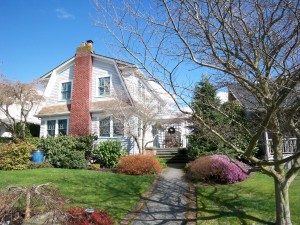What goes around comes around. There is nothing new under the sun. Been there, done that. Yada, yada, yada.
Housing trends (like most trends) tend to wax and wane over the years, but they often retain something from previous generations. It’s like . . . deja vu all over again. Which is exactly what happened in the 1920s with certain types of housing designs. 
More accurately called the Dutch Colonial Revival, this quaint, whimsical style reflects early 19th century Americans’ tie with their European roots. While homeowners from earlier decades focused on practicality or the demonstration of wealth, home buyers from the 1920s leaned further towards sentiment and romanticism than ever before.
The Dutch Colonial style house was a throwback to the Dutch colonists who settled in the lower parts of New York and New Jersey. This architecture conveys the importance of domesticity, family life, and nostalgia.
Usually built with wood, brick, or stone, with a shingle gambrel roof, the Dutch Colonial saw its heyday between 1910-1928. Easy to identify, the Dutch Colonial typically has a symmetrical two-sided roof with two slopes on each side, curved or flared eaves, and resembles a barn. Depending on the variety, the entryways to these homes are decorated with a hood or type of dormer.
Here are a few different types of Dutch Colonial homes:
Sears Verona (which looks like the Fisher Price House to me)
According to historians, folks in the 20s were less concerned with impractical excess and showing off their social status. Instead they were more content to hunker down and enjoy the security of family life and the convenience of new technology. They had survived the Great War and were enjoying the fruits of the manufacturing boom.
During this decade, cars, radios, refrigerators, washing machines, electric irons and other appliances flooded the markets, much to the delight of grateful consumers.
With the US gross national product skyrocketing at $93 billion in 1924 (up from $69 in 1921), and unemployment at 3.7% by1929, many Americans had the luxury of looking back at their roots with nostalgia while looking towards their future with bright eyed idealism. The care and charm that went into the Dutch Colonial house certainly reflects this.
“We in America today are nearer to the final triumph over poverty than ever before in the history of any land,” declared Herbert Hoover after accepting the Republican presidential nomination in August of 1928.
The unexpected turmoil in the 30s definitely impacted the next stage of home building. Stay tuned while we look into the history behind the Tudor, Cape Cod, and Mid-Century home styles.
I hope you’re enjoying our historical tour of the evolution of housing trends. My name is Joni Kerley, I specialize in Snohomish County real estate. Got your sights set on a Dutch Colonial from the roaring 20s? For more information on these and other styles in our area, give me a call at 425-343-4545.
Photo © 2011 Joni Kerley

Comments(0)